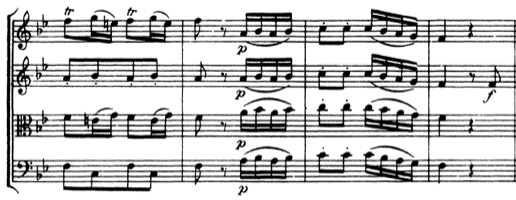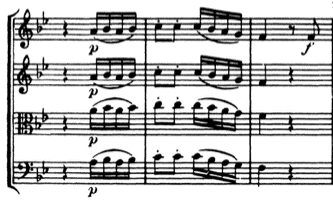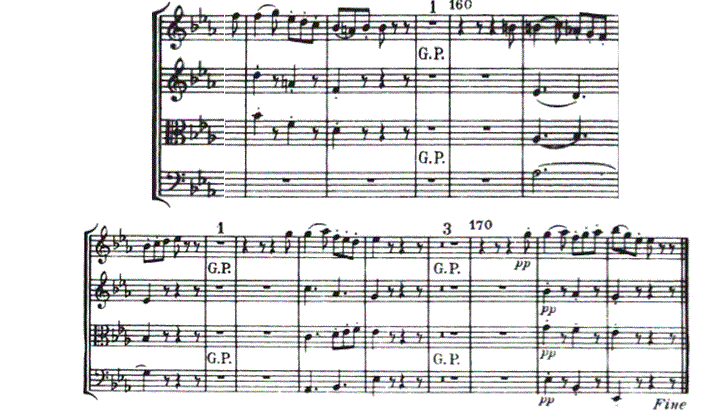Humor is often considered a hallmark of Haydn‘s music; yet, humor emerged as an intrinsic element of the composer’s style only around 1780. Therefore, the presence of humor in Op. 33 suggests another musical trait that differentiates these string quartets from Op. 20. The humor in question refers to the interplay of expectation and surprise that ensues. Steven Paul supports this interpretation: “Haydn’s humor, however, was not merely designed to entertain, amuse, or even fool musical performers and audiences. It also plays an important role in the form and structure of his music by providing elements of relaxation, comic relief, and variety.” For this reason, the term “wit,” with its emphasis on clever playfulness, may be more appropriate than “humor.”[1] In Mark Evan Bonds’ “Haydn, Laurence Sterne, and the Origins of Musical Irony,” the author asserts that Haydn’s instrumental music “succeeded in calling attention to the very artificiality of [his] own works” (he claims that Haydn and Sterne both do this, albeit in different artistic media).[2]
Haydn’s conscious implementation of his wittiness to his audience represents a new, highly personal, and interactive perspective towards his music. This notion, which was highly innovative during Haydn’s time, is elucidated well in an 1807 article written by Haydn’s contemporary, the philosopher C.F. Michaelis: “Music is humorous when the composition accords with the mood of the artist rather than strictly adhering to an artistic system. The musical thoughts are then of a “new and special” kind; they do not follow each other in a way one would expect, but they surprise by totally unexpected turns and transitions.”[3] However, this is not to say that these quartets contain the very first examples of humor in Haydn’s music; there are some early examples in Op. 20, as we shall see. But the level of sophistication of Haydn’s sense of humor in Op. 33 surpasses all his previous works, Op. 20 included.
As was mentioned above regarding the rondo form, one component of Haydn’s sense of humor is his ability to thwart the audience’s sense of expectation. An early example of the composer’s penchant for the unexpected can be found in the opening theme of Op. 20 no. 3. Here, the theme is broken into two phrases of seven measures each, directly contradicting the popular galant style of the time, which was a reaction against the showy, overly ornamented music of the late Baroque era (Figure 4.a).
Figure 4.a, Op. 20, No. 3, first mvt, mm. 1-7
A typical galant phrase structure was based on a series of modules of two or four measures, producing a square structure, and this is just what Haydn avoids here. The use of uneven numbers of measures returns in the second movement, a minuet. Just as he did in the first movement, Haydn breaks the opening theme into two phrases of an odd number of measures, in this case five. This type of manipulation is indeed clever, but is not as immediately apparent to the listener as that of Op. 33. Haydn would use such disruptions in Op. 33 to an even greater extent, as this article will soon explore.
The unexpected is an element of Op. 20 in other ways as well. In the first movement of Op. 20 no. 3, Haydn employs brief unison passages, a common practice at the time, to a decidedly different end in measures 24-25 (Figure 4.b), 107-108 (Figure 4.c), 145-146, 151-152, and 240-241.
 Figure 4.b, Op. 20, No. 3, first mvt, mm. 23-25
Figure 4.b, Op. 20, No. 3, first mvt, mm. 23-25
____________________________________________________________ Figure 4.c, Op. 20, No. 3, first mvt, mm. 107-109
Figure 4.c, Op. 20, No. 3, first mvt, mm. 107-109
Usually, passages of this nature would be written with forte dynamic markings for a powerful effect, especially since they are in the relative major key of the movement, but here Haydn instead marks them piano in order to achieve a more subtle, somewhat perplexing sound. The ending of the first movement of Op. 20 no. 3 also plays with the unexpected. The forte cadence on measure 268 is eight measures in the making. These eight measures outline each instrument slowly building, calling and answering, toward this forte tonic. The listener would be entirely satisfied with the movement ending this way, but Haydn decides to prolong the audience’s expectations with a second, quick cadence, marked piano. In this movement can be found some of the most closely related examples of “humor” to Op. 33, albeit still light-years away from the later Haydn’s interpretation of this concept.
The finale of Op. 33 no. 2—the so-called “Joke” quartet—is a crystal-clear example of Haydn’s newfound humor. Any listener, having never heard the piece before – from the layperson with no musical background to the musicologist – is taken by the “surprise” ending. This quality is especially reflective of Haydn’s newly shifted focus towards his audience, which lends itself to such entertaining moments as this ending. The structure of this finale’s rondo (A-B-A-C-A), as previously discussed, is another revealing decision made by the audience-conscious Haydn. At the end of this rondo, beginning with a fermata at measure 148, the composer begins to set up his joke (Figure 1.b).
 Figure 1.b Op. 33, No. 2, fourth mvt, mm.157-172
Figure 1.b Op. 33, No. 2, fourth mvt, mm.157-172
The long pause could imply an ending, but this notion is abruptly dismissed by a forte sixteenth note at the beginning of the miniature Adagio section which lasts for a scant four bars. Next, the first violin plays the opening theme, only to be interrupted every two bars by rests that grow progressively longer. Compounding this unsettling cliffhanger are the dynamic markings used. The music diminishes in volume until the eventual ending, which is pianissimo, at which point the audience finally breathes a collective sigh of relief. This oft-cited example of Haydn’s wit is certainly important, but it is only one of numerous other examples.
The finales of Haydn’s quartets are often rife with humor, as the finale of Op. 33 no. 4 demonstrates. The feel of this presto movement is playful, which suits the surprise ending well. Two unexpectedly long pauses at measures 197 and 199 set the stage for the final ten measures, which are both marked pizzicato and piano. Since this movement contains no previous examples of pizzicato dynamic markings – or rests longer than a quarter note (not counting fermatas) for that matter – this decision is startling, yet oddly satisfying. It is almost a welcome respite from the previous nonstop barrage of notes; an effect of which the new listener-motivated Haydn was undoubtedly seeking.
A more subtle yet equally comical passage can be found in the B-section of this rondo, beginning at m. 16. Here, Haydn begins a drawn out, overly dramatic preparation of the dominant that lasts for thirteen measures, only to result in a mere recapitulation of the main theme, which is almost mockingly small. Again, Haydn manipulates the audience by cutting their expectations short; one would expect a grander, more triumphant resolution of this tension, but instead is parsimoniously rewarded with a rehashing of previous material.
Another example of Haydn’s more subtle wittiness in this set is in Op. 33 no. 3, commonly referred to as “The Bird.” The beginning of the piece subverts audience expectations without necessarily embarrassing listeners, as the finale of no. 2 might have (i.e., premature applause). Instead, the first seventeen measures act as a kind of introduction before m. 18, which could be argued as the definitive start of the piece. The half note rests at measure 6 and 12 break up this introduction in a way that does not imply a real beginning. Furthermore, the leading tone is flatted in m. 13, which creates a sort of temporary minor feel. Measure 17 finally resolves this tension, bringing the music home with a cadential 6-4 chord preceding a perfect authentic cadence. At this point, the piece finally feels as though it is justified in beginning in full; the slight confusion that precedes this moment strengthens this feeling.
By employing such witty tactics, Haydn was able to draw his listeners in rather than alienate them, which was a distinct possibility with such aesthetically risky decisions as were made in Op. 33. Op. 33’s use of the unexpected, themes with uneven numbers of measures, surprise endings, and even surprise beginnings, all showcase Haydn’s humorous range. Humor was not new for him, as Op. 20 shows, but Op. 33 marks the first time Haydn employed sophisticated moments of musical wit throughout a work.
With this, as with the other areas we have surveyed, we can see that the Op. 33 quartets differ from their contemporaries in a manner that certainly denotes a new and special quality. The use of rondo form, evolutionary textures, and amusing wit all acted to engage the audience and leave them entertained to an extent that even the masterful Op. 20 could not achieve. Haydn had every reason to compose and market such innovative music to an audience that the Enlightenment had acted upon, and to which his renegotiated contract gave access. It thusly seems justified to take Haydn’s written word, and to give to Op. 33 the credit it deserves as a groundbreaking work of art.

